Industrial Relations: Exploring the Employment Relationship Dynamics
VerifiedAdded on 2022/02/05
|48
|19917
|32
Report
AI Summary
This report provides an in-depth analysis of the employment relationship within the field of industrial relations. It begins by defining industrial relations (IR) and distinguishing it from personnel management (PM) and human resource management (HRM). The report emphasizes the significance of paid employment for both employees and employers, highlighting its role in income, identity, and competitive advantage. It explores the importance of the employment relationship in organizing human resources and addresses the interplay of control and consent. The report further examines key issues in the regulation of work, including labor market participation, pay, and inequality, along with the trends of economically inactive people and the polarization of work. It also includes data and statistics from the UK to illustrate these points and concludes with a discussion of the analytical approaches used within IR as a field of study, and the structure of the book from which the chapter is taken.
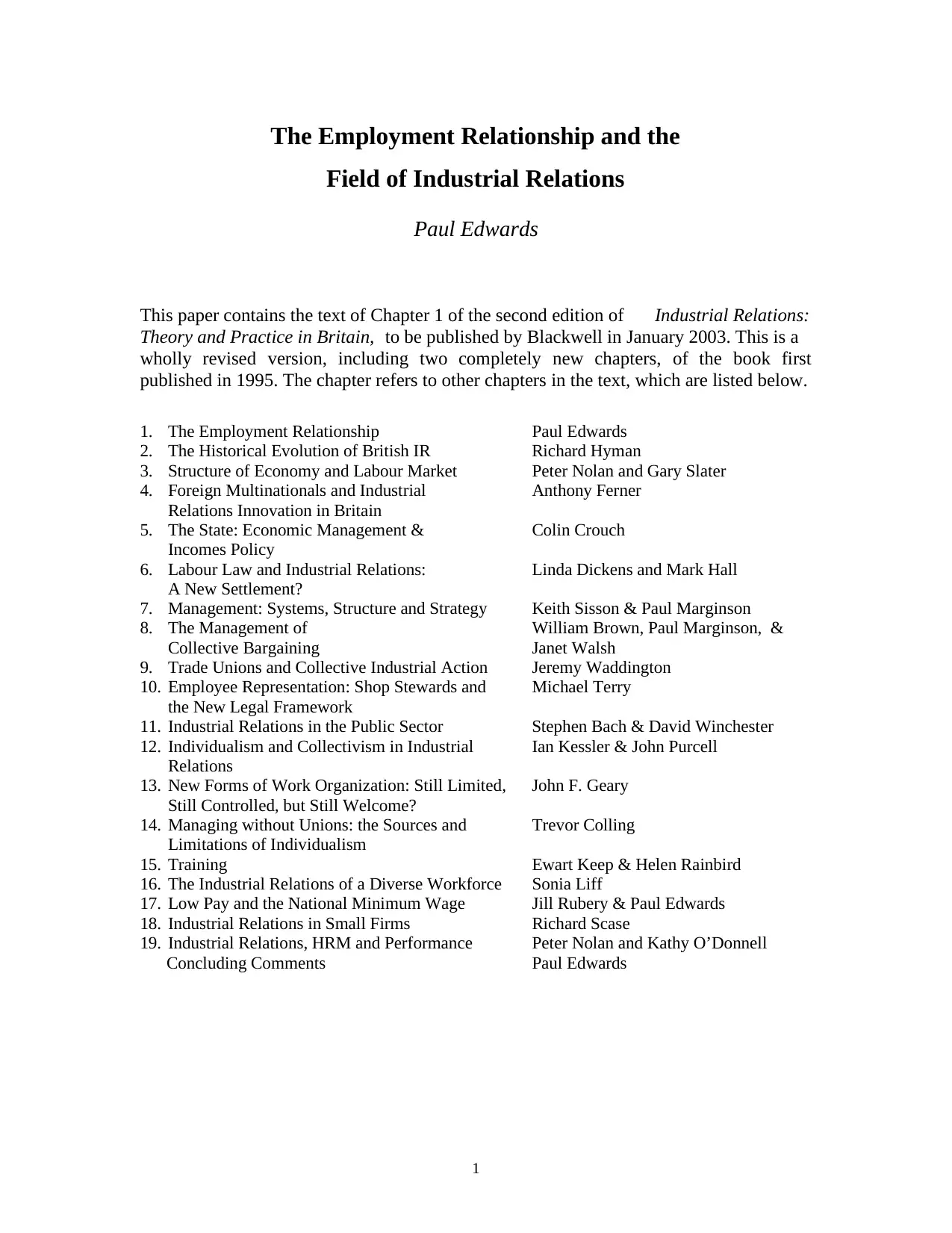
1
The Employment Relationship and the
Field of Industrial Relations
Paul Edwards
This paper contains the text of Chapter 1 of the second edition of Industrial Relations:
Theory and Practice in Britain, to be published by Blackwell in January 2003. This is a
wholly revised version, including two completely new chapters, of the book first
published in 1995. The chapter refers to other chapters in the text, which are listed below.
1. The Employment Relationship Paul Edwards
2. The Historical Evolution of British IR Richard Hyman
3. Structure of Economy and Labour Market Peter Nolan and Gary Slater
4. Foreign Multinationals and Industrial Anthony Ferner
Relations Innovation in Britain
5. The State: Economic Management & Colin Crouch
Incomes Policy
6. Labour Law and Industrial Relations: Linda Dickens and Mark Hall
A New Settlement?
7. Management: Systems, Structure and Strategy Keith Sisson & Paul Marginson
8. The Management of William Brown, Paul Marginson, &
Collective Bargaining Janet Walsh
9. Trade Unions and Collective Industrial Action Jeremy Waddington
10. Employee Representation: Shop Stewards and Michael Terry
the New Legal Framework
11. Industrial Relations in the Public Sector Stephen Bach & David Winchester
12. Individualism and Collectivism in Industrial Ian Kessler & John Purcell
Relations
13. New Forms of Work Organization: Still Limited, John F. Geary
Still Controlled, but Still Welcome?
14. Managing without Unions: the Sources and Trevor Colling
Limitations of Individualism
15. Training Ewart Keep & Helen Rainbird
16. The Industrial Relations of a Diverse Workforce Sonia Liff
17. Low Pay and the National Minimum Wage Jill Rubery & Paul Edwards
18. Industrial Relations in Small Firms Richard Scase
19. Industrial Relations, HRM and Performance Peter Nolan and Kathy O’Donnell
Concluding Comments Paul Edwards
The Employment Relationship and the
Field of Industrial Relations
Paul Edwards
This paper contains the text of Chapter 1 of the second edition of Industrial Relations:
Theory and Practice in Britain, to be published by Blackwell in January 2003. This is a
wholly revised version, including two completely new chapters, of the book first
published in 1995. The chapter refers to other chapters in the text, which are listed below.
1. The Employment Relationship Paul Edwards
2. The Historical Evolution of British IR Richard Hyman
3. Structure of Economy and Labour Market Peter Nolan and Gary Slater
4. Foreign Multinationals and Industrial Anthony Ferner
Relations Innovation in Britain
5. The State: Economic Management & Colin Crouch
Incomes Policy
6. Labour Law and Industrial Relations: Linda Dickens and Mark Hall
A New Settlement?
7. Management: Systems, Structure and Strategy Keith Sisson & Paul Marginson
8. The Management of William Brown, Paul Marginson, &
Collective Bargaining Janet Walsh
9. Trade Unions and Collective Industrial Action Jeremy Waddington
10. Employee Representation: Shop Stewards and Michael Terry
the New Legal Framework
11. Industrial Relations in the Public Sector Stephen Bach & David Winchester
12. Individualism and Collectivism in Industrial Ian Kessler & John Purcell
Relations
13. New Forms of Work Organization: Still Limited, John F. Geary
Still Controlled, but Still Welcome?
14. Managing without Unions: the Sources and Trevor Colling
Limitations of Individualism
15. Training Ewart Keep & Helen Rainbird
16. The Industrial Relations of a Diverse Workforce Sonia Liff
17. Low Pay and the National Minimum Wage Jill Rubery & Paul Edwards
18. Industrial Relations in Small Firms Richard Scase
19. Industrial Relations, HRM and Performance Peter Nolan and Kathy O’Donnell
Concluding Comments Paul Edwards
Paraphrase This Document
Need a fresh take? Get an instant paraphrase of this document with our AI Paraphraser
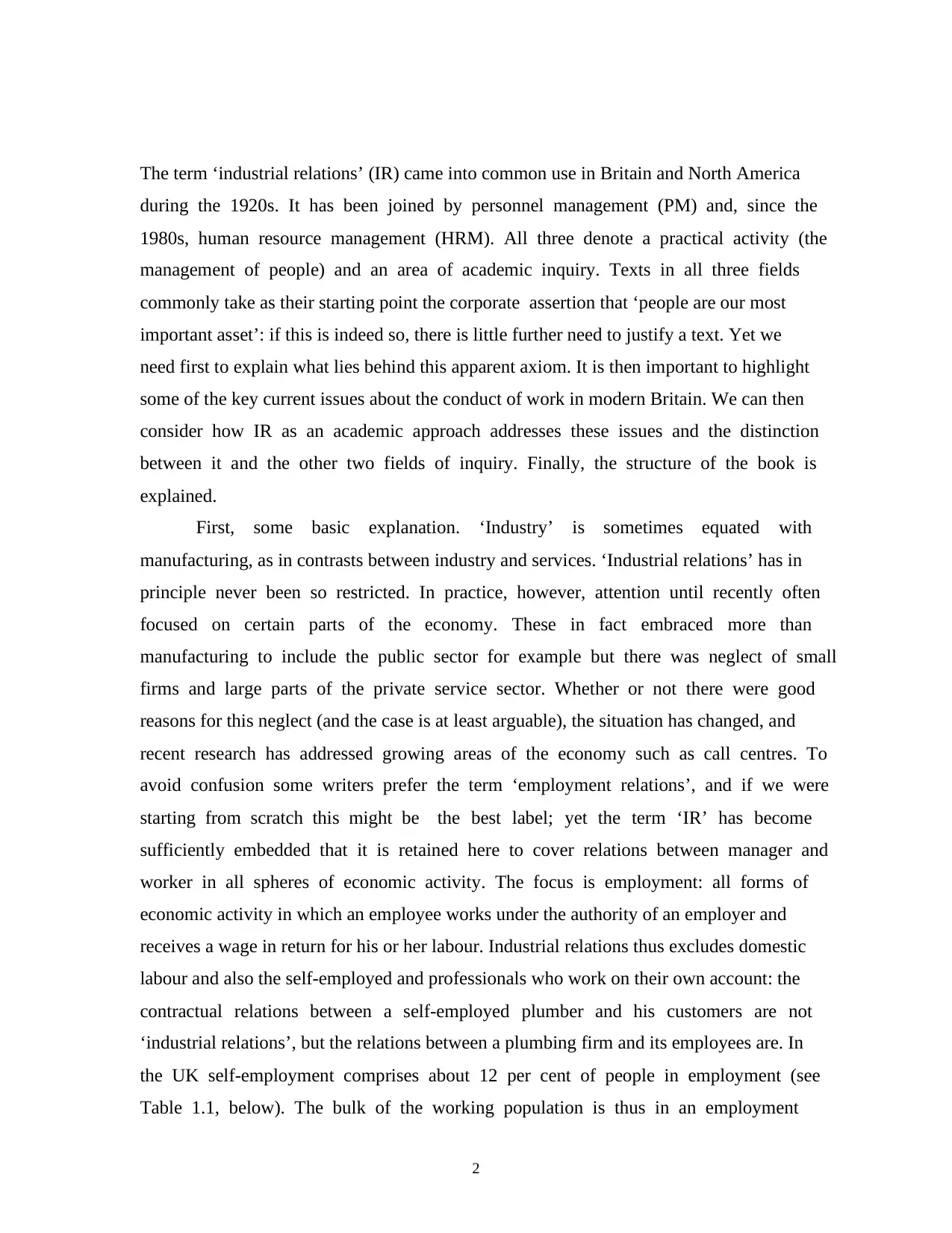
2
The term ‘industrial relations’ (IR) came into common use in Britain and North America
during the 1920s. It has been joined by personnel management (PM) and, since the
1980s, human resource management (HRM). All three denote a practical activity (the
management of people) and an area of academic inquiry. Texts in all three fields
commonly take as their starting point the corporate assertion that ‘people are our most
important asset’: if this is indeed so, there is little further need to justify a text. Yet we
need first to explain what lies behind this apparent axiom. It is then important to highlight
some of the key current issues about the conduct of work in modern Britain. We can then
consider how IR as an academic approach addresses these issues and the distinction
between it and the other two fields of inquiry. Finally, the structure of the book is
explained.
First, some basic explanation. ‘Industry’ is sometimes equated with
manufacturing, as in contrasts between industry and services. ‘Industrial relations’ has in
principle never been so restricted. In practice, however, attention until recently often
focused on certain parts of the economy. These in fact embraced more than
manufacturing to include the public sector for example but there was neglect of small
firms and large parts of the private service sector. Whether or not there were good
reasons for this neglect (and the case is at least arguable), the situation has changed, and
recent research has addressed growing areas of the economy such as call centres. To
avoid confusion some writers prefer the term ‘employment relations’, and if we were
starting from scratch this might be the best label; yet the term ‘IR’ has become
sufficiently embedded that it is retained here to cover relations between manager and
worker in all spheres of economic activity. The focus is employment: all forms of
economic activity in which an employee works under the authority of an employer and
receives a wage in return for his or her labour. Industrial relations thus excludes domestic
labour and also the self-employed and professionals who work on their own account: the
contractual relations between a self-employed plumber and his customers are not
‘industrial relations’, but the relations between a plumbing firm and its employees are. In
the UK self-employment comprises about 12 per cent of people in employment (see
Table 1.1, below). The bulk of the working population is thus in an employment
The term ‘industrial relations’ (IR) came into common use in Britain and North America
during the 1920s. It has been joined by personnel management (PM) and, since the
1980s, human resource management (HRM). All three denote a practical activity (the
management of people) and an area of academic inquiry. Texts in all three fields
commonly take as their starting point the corporate assertion that ‘people are our most
important asset’: if this is indeed so, there is little further need to justify a text. Yet we
need first to explain what lies behind this apparent axiom. It is then important to highlight
some of the key current issues about the conduct of work in modern Britain. We can then
consider how IR as an academic approach addresses these issues and the distinction
between it and the other two fields of inquiry. Finally, the structure of the book is
explained.
First, some basic explanation. ‘Industry’ is sometimes equated with
manufacturing, as in contrasts between industry and services. ‘Industrial relations’ has in
principle never been so restricted. In practice, however, attention until recently often
focused on certain parts of the economy. These in fact embraced more than
manufacturing to include the public sector for example but there was neglect of small
firms and large parts of the private service sector. Whether or not there were good
reasons for this neglect (and the case is at least arguable), the situation has changed, and
recent research has addressed growing areas of the economy such as call centres. To
avoid confusion some writers prefer the term ‘employment relations’, and if we were
starting from scratch this might be the best label; yet the term ‘IR’ has become
sufficiently embedded that it is retained here to cover relations between manager and
worker in all spheres of economic activity. The focus is employment: all forms of
economic activity in which an employee works under the authority of an employer and
receives a wage in return for his or her labour. Industrial relations thus excludes domestic
labour and also the self-employed and professionals who work on their own account: the
contractual relations between a self-employed plumber and his customers are not
‘industrial relations’, but the relations between a plumbing firm and its employees are. In
the UK self-employment comprises about 12 per cent of people in employment (see
Table 1.1, below). The bulk of the working population is thus in an employment
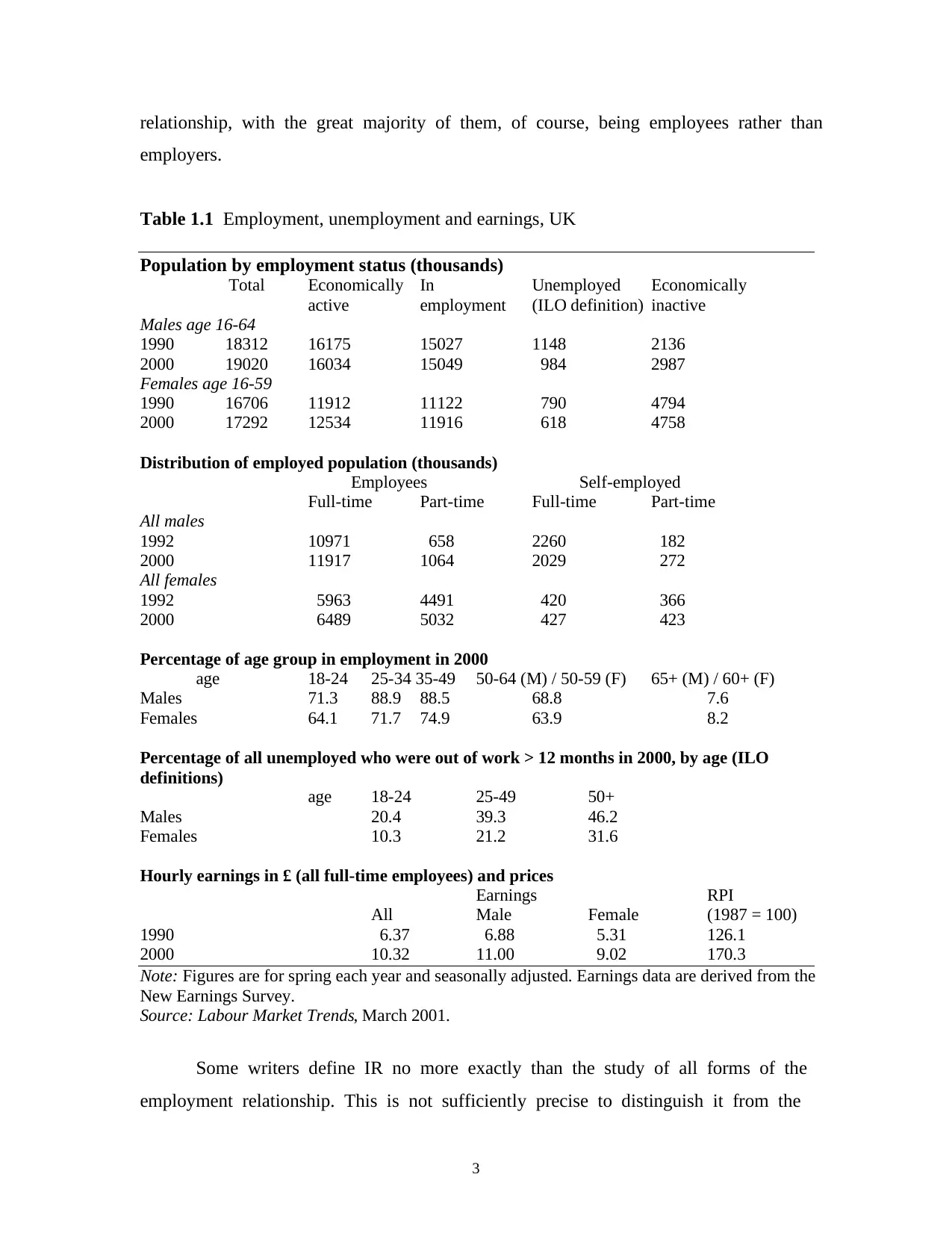
3
relationship, with the great majority of them, of course, being employees rather than
employers.
Table 1.1 Employment, unemployment and earnings, UK
Population by employment status (thousands)
Total Economically In Unemployed Economically
active employment (ILO definition) inactive
Males age 16-64
1990 18312 16175 15027 1148 2136
2000 19020 16034 15049 984 2987
Females age 16-59
1990 16706 11912 11122 790 4794
2000 17292 12534 11916 618 4758
Distribution of employed population (thousands)
Employees Self-employed
Full-time Part-time Full-time Part-time
All males
1992 10971 658 2260 182
2000 11917 1064 2029 272
All females
1992 5963 4491 420 366
2000 6489 5032 427 423
Percentage of age group in employment in 2000
age 18-24 25-34 35-49 50-64 (M) / 50-59 (F) 65+ (M) / 60+ (F)
Males 71.3 88.9 88.5 68.8 7.6
Females 64.1 71.7 74.9 63.9 8.2
Percentage of all unemployed who were out of work > 12 months in 2000, by age (ILO
definitions)
age 18-24 25-49 50+
Males 20.4 39.3 46.2
Females 10.3 21.2 31.6
Hourly earnings in £ (all full-time employees) and prices
Earnings RPI
All Male Female (1987 = 100)
1990 6.37 6.88 5.31 126.1
2000 10.32 11.00 9.02 170.3
Note: Figures are for spring each year and seasonally adjusted. Earnings data are derived from the
New Earnings Survey.
Source: Labour Market Trends, March 2001.
Some writers define IR no more exactly than the study of all forms of the
employment relationship. This is not sufficiently precise to distinguish it from the
relationship, with the great majority of them, of course, being employees rather than
employers.
Table 1.1 Employment, unemployment and earnings, UK
Population by employment status (thousands)
Total Economically In Unemployed Economically
active employment (ILO definition) inactive
Males age 16-64
1990 18312 16175 15027 1148 2136
2000 19020 16034 15049 984 2987
Females age 16-59
1990 16706 11912 11122 790 4794
2000 17292 12534 11916 618 4758
Distribution of employed population (thousands)
Employees Self-employed
Full-time Part-time Full-time Part-time
All males
1992 10971 658 2260 182
2000 11917 1064 2029 272
All females
1992 5963 4491 420 366
2000 6489 5032 427 423
Percentage of age group in employment in 2000
age 18-24 25-34 35-49 50-64 (M) / 50-59 (F) 65+ (M) / 60+ (F)
Males 71.3 88.9 88.5 68.8 7.6
Females 64.1 71.7 74.9 63.9 8.2
Percentage of all unemployed who were out of work > 12 months in 2000, by age (ILO
definitions)
age 18-24 25-49 50+
Males 20.4 39.3 46.2
Females 10.3 21.2 31.6
Hourly earnings in £ (all full-time employees) and prices
Earnings RPI
All Male Female (1987 = 100)
1990 6.37 6.88 5.31 126.1
2000 10.32 11.00 9.02 170.3
Note: Figures are for spring each year and seasonally adjusted. Earnings data are derived from the
New Earnings Survey.
Source: Labour Market Trends, March 2001.
Some writers define IR no more exactly than the study of all forms of the
employment relationship. This is not sufficiently precise to distinguish it from the
⊘ This is a preview!⊘
Do you want full access?
Subscribe today to unlock all pages.

Trusted by 1+ million students worldwide
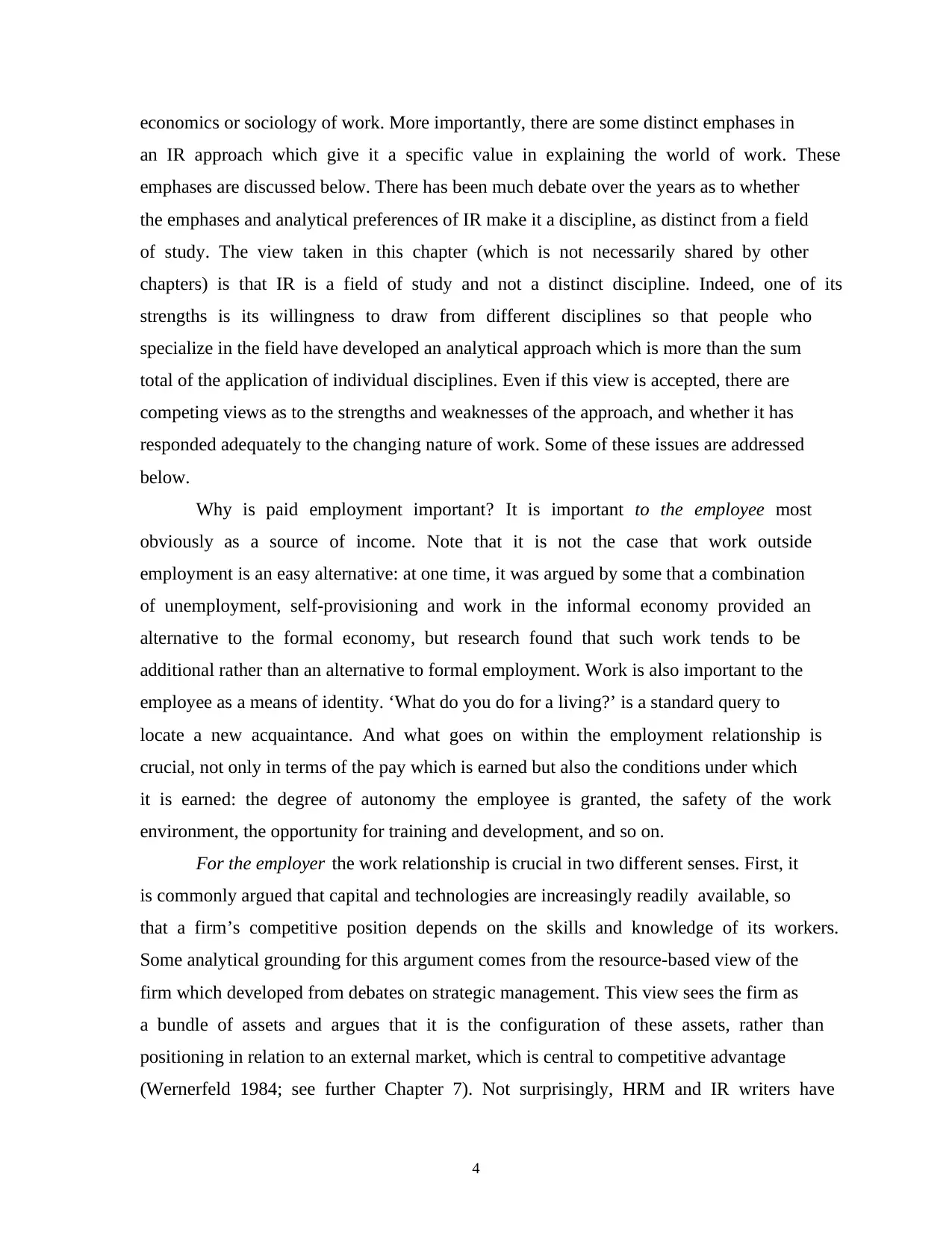
4
economics or sociology of work. More importantly, there are some distinct emphases in
an IR approach which give it a specific value in explaining the world of work. These
emphases are discussed below. There has been much debate over the years as to whether
the emphases and analytical preferences of IR make it a discipline, as distinct from a field
of study. The view taken in this chapter (which is not necessarily shared by other
chapters) is that IR is a field of study and not a distinct discipline. Indeed, one of its
strengths is its willingness to draw from different disciplines so that people who
specialize in the field have developed an analytical approach which is more than the sum
total of the application of individual disciplines. Even if this view is accepted, there are
competing views as to the strengths and weaknesses of the approach, and whether it has
responded adequately to the changing nature of work. Some of these issues are addressed
below.
Why is paid employment important? It is important to the employee most
obviously as a source of income. Note that it is not the case that work outside
employment is an easy alternative: at one time, it was argued by some that a combination
of unemployment, self-provisioning and work in the informal economy provided an
alternative to the formal economy, but research found that such work tends to be
additional rather than an alternative to formal employment. Work is also important to the
employee as a means of identity. ‘What do you do for a living?’ is a standard query to
locate a new acquaintance. And what goes on within the employment relationship is
crucial, not only in terms of the pay which is earned but also the conditions under which
it is earned: the degree of autonomy the employee is granted, the safety of the work
environment, the opportunity for training and development, and so on.
For the employer the work relationship is crucial in two different senses. First, it
is commonly argued that capital and technologies are increasingly readily available, so
that a firm’s competitive position depends on the skills and knowledge of its workers.
Some analytical grounding for this argument comes from the resource-based view of the
firm which developed from debates on strategic management. This view sees the firm as
a bundle of assets and argues that it is the configuration of these assets, rather than
positioning in relation to an external market, which is central to competitive advantage
(Wernerfeld 1984; see further Chapter 7). Not surprisingly, HRM and IR writers have
economics or sociology of work. More importantly, there are some distinct emphases in
an IR approach which give it a specific value in explaining the world of work. These
emphases are discussed below. There has been much debate over the years as to whether
the emphases and analytical preferences of IR make it a discipline, as distinct from a field
of study. The view taken in this chapter (which is not necessarily shared by other
chapters) is that IR is a field of study and not a distinct discipline. Indeed, one of its
strengths is its willingness to draw from different disciplines so that people who
specialize in the field have developed an analytical approach which is more than the sum
total of the application of individual disciplines. Even if this view is accepted, there are
competing views as to the strengths and weaknesses of the approach, and whether it has
responded adequately to the changing nature of work. Some of these issues are addressed
below.
Why is paid employment important? It is important to the employee most
obviously as a source of income. Note that it is not the case that work outside
employment is an easy alternative: at one time, it was argued by some that a combination
of unemployment, self-provisioning and work in the informal economy provided an
alternative to the formal economy, but research found that such work tends to be
additional rather than an alternative to formal employment. Work is also important to the
employee as a means of identity. ‘What do you do for a living?’ is a standard query to
locate a new acquaintance. And what goes on within the employment relationship is
crucial, not only in terms of the pay which is earned but also the conditions under which
it is earned: the degree of autonomy the employee is granted, the safety of the work
environment, the opportunity for training and development, and so on.
For the employer the work relationship is crucial in two different senses. First, it
is commonly argued that capital and technologies are increasingly readily available, so
that a firm’s competitive position depends on the skills and knowledge of its workers.
Some analytical grounding for this argument comes from the resource-based view of the
firm which developed from debates on strategic management. This view sees the firm as
a bundle of assets and argues that it is the configuration of these assets, rather than
positioning in relation to an external market, which is central to competitive advantage
(Wernerfeld 1984; see further Chapter 7). Not surprisingly, HRM and IR writers have
Paraphrase This Document
Need a fresh take? Get an instant paraphrase of this document with our AI Paraphraser
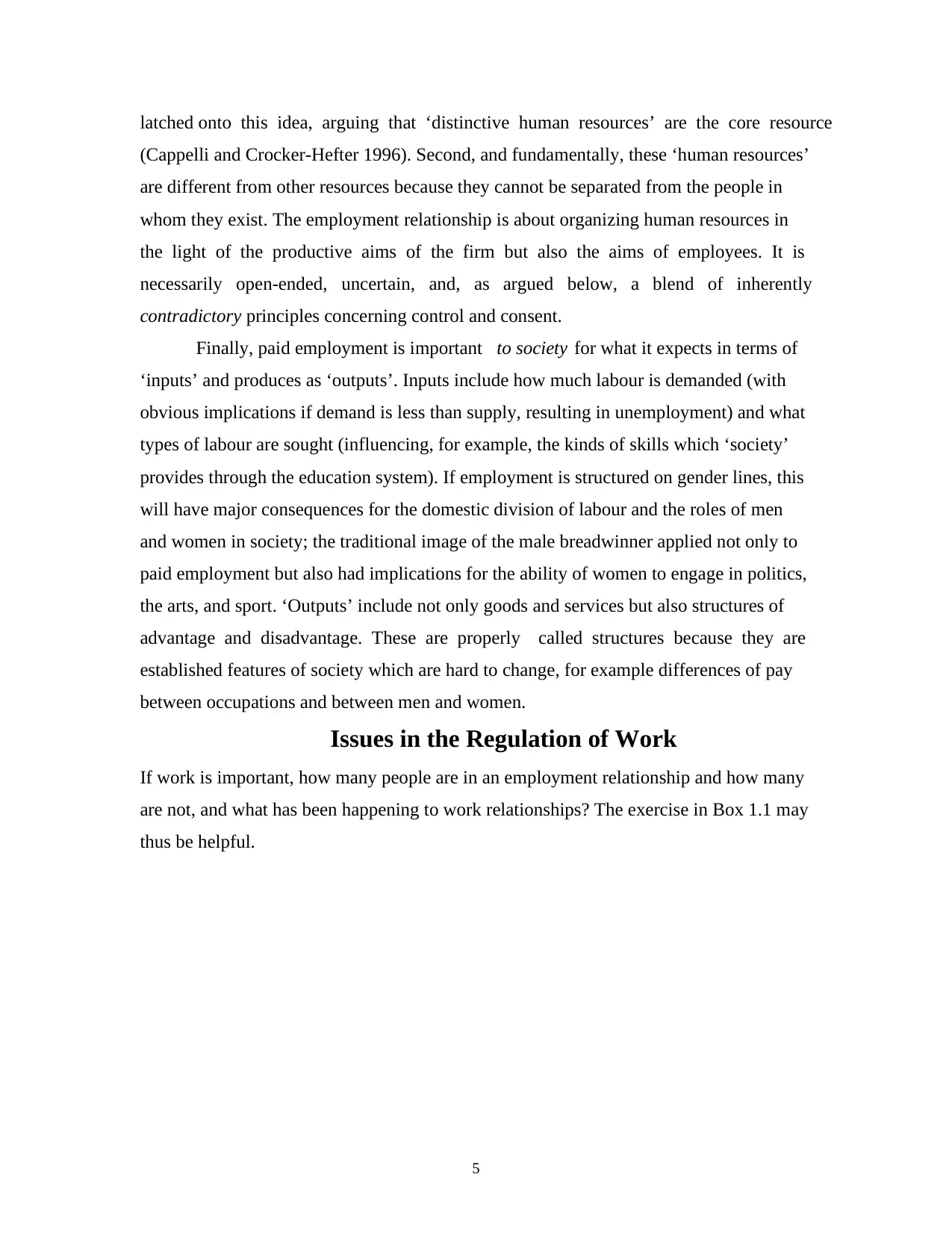
5
latched onto this idea, arguing that ‘distinctive human resources’ are the core resource
(Cappelli and Crocker-Hefter 1996). Second, and fundamentally, these ‘human resources’
are different from other resources because they cannot be separated from the people in
whom they exist. The employment relationship is about organizing human resources in
the light of the productive aims of the firm but also the aims of employees. It is
necessarily open-ended, uncertain, and, as argued below, a blend of inherently
contradictory principles concerning control and consent.
Finally, paid employment is important to society for what it expects in terms of
‘inputs’ and produces as ‘outputs’. Inputs include how much labour is demanded (with
obvious implications if demand is less than supply, resulting in unemployment) and what
types of labour are sought (influencing, for example, the kinds of skills which ‘society’
provides through the education system). If employment is structured on gender lines, this
will have major consequences for the domestic division of labour and the roles of men
and women in society; the traditional image of the male breadwinner applied not only to
paid employment but also had implications for the ability of women to engage in politics,
the arts, and sport. ‘Outputs’ include not only goods and services but also structures of
advantage and disadvantage. These are properly called structures because they are
established features of society which are hard to change, for example differences of pay
between occupations and between men and women.
Issues in the Regulation of Work
If work is important, how many people are in an employment relationship and how many
are not, and what has been happening to work relationships? The exercise in Box 1.1 may
thus be helpful.
latched onto this idea, arguing that ‘distinctive human resources’ are the core resource
(Cappelli and Crocker-Hefter 1996). Second, and fundamentally, these ‘human resources’
are different from other resources because they cannot be separated from the people in
whom they exist. The employment relationship is about organizing human resources in
the light of the productive aims of the firm but also the aims of employees. It is
necessarily open-ended, uncertain, and, as argued below, a blend of inherently
contradictory principles concerning control and consent.
Finally, paid employment is important to society for what it expects in terms of
‘inputs’ and produces as ‘outputs’. Inputs include how much labour is demanded (with
obvious implications if demand is less than supply, resulting in unemployment) and what
types of labour are sought (influencing, for example, the kinds of skills which ‘society’
provides through the education system). If employment is structured on gender lines, this
will have major consequences for the domestic division of labour and the roles of men
and women in society; the traditional image of the male breadwinner applied not only to
paid employment but also had implications for the ability of women to engage in politics,
the arts, and sport. ‘Outputs’ include not only goods and services but also structures of
advantage and disadvantage. These are properly called structures because they are
established features of society which are hard to change, for example differences of pay
between occupations and between men and women.
Issues in the Regulation of Work
If work is important, how many people are in an employment relationship and how many
are not, and what has been happening to work relationships? The exercise in Box 1.1 may
thus be helpful.
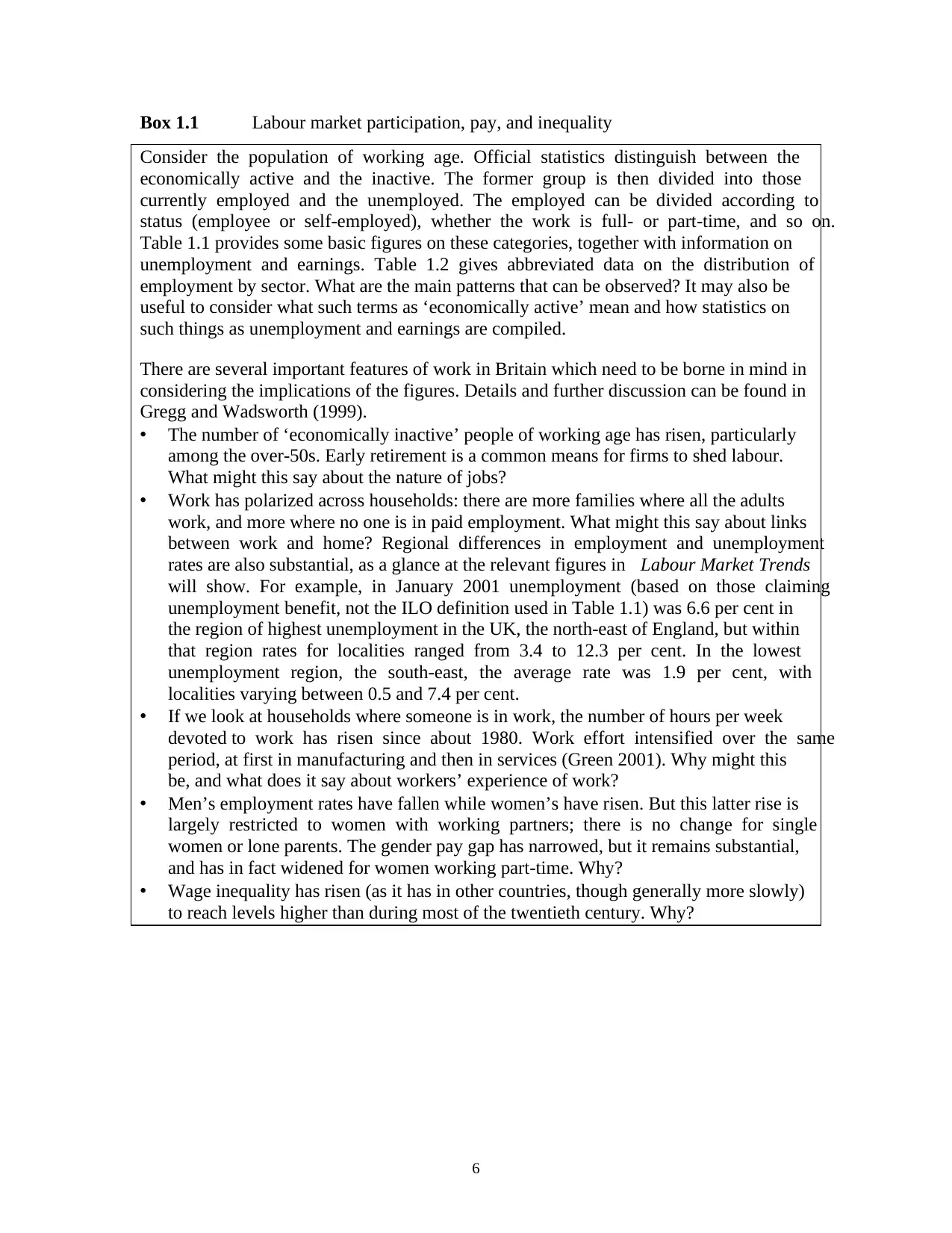
6
Box 1.1 Labour market participation, pay, and inequality
Consider the population of working age. Official statistics distinguish between the
economically active and the inactive. The former group is then divided into those
currently employed and the unemployed. The employed can be divided according to
status (employee or self-employed), whether the work is full- or part-time, and so on.
Table 1.1 provides some basic figures on these categories, together with information on
unemployment and earnings. Table 1.2 gives abbreviated data on the distribution of
employment by sector. What are the main patterns that can be observed? It may also be
useful to consider what such terms as ‘economically active’ mean and how statistics on
such things as unemployment and earnings are compiled.
There are several important features of work in Britain which need to be borne in mind in
considering the implications of the figures. Details and further discussion can be found in
Gregg and Wadsworth (1999).
• The number of ‘economically inactive’ people of working age has risen, particularly
among the over-50s. Early retirement is a common means for firms to shed labour.
What might this say about the nature of jobs?
• Work has polarized across households: there are more families where all the adults
work, and more where no one is in paid employment. What might this say about links
between work and home? Regional differences in employment and unemployment
rates are also substantial, as a glance at the relevant figures in Labour Market Trends
will show. For example, in January 2001 unemployment (based on those claiming
unemployment benefit, not the ILO definition used in Table 1.1) was 6.6 per cent in
the region of highest unemployment in the UK, the north-east of England, but within
that region rates for localities ranged from 3.4 to 12.3 per cent. In the lowest
unemployment region, the south-east, the average rate was 1.9 per cent, with
localities varying between 0.5 and 7.4 per cent.
• If we look at households where someone is in work, the number of hours per week
devoted to work has risen since about 1980. Work effort intensified over the same
period, at first in manufacturing and then in services (Green 2001). Why might this
be, and what does it say about workers’ experience of work?
• Men’s employment rates have fallen while women’s have risen. But this latter rise is
largely restricted to women with working partners; there is no change for single
women or lone parents. The gender pay gap has narrowed, but it remains substantial,
and has in fact widened for women working part-time. Why?
• Wage inequality has risen (as it has in other countries, though generally more slowly)
to reach levels higher than during most of the twentieth century. Why?
Box 1.1 Labour market participation, pay, and inequality
Consider the population of working age. Official statistics distinguish between the
economically active and the inactive. The former group is then divided into those
currently employed and the unemployed. The employed can be divided according to
status (employee or self-employed), whether the work is full- or part-time, and so on.
Table 1.1 provides some basic figures on these categories, together with information on
unemployment and earnings. Table 1.2 gives abbreviated data on the distribution of
employment by sector. What are the main patterns that can be observed? It may also be
useful to consider what such terms as ‘economically active’ mean and how statistics on
such things as unemployment and earnings are compiled.
There are several important features of work in Britain which need to be borne in mind in
considering the implications of the figures. Details and further discussion can be found in
Gregg and Wadsworth (1999).
• The number of ‘economically inactive’ people of working age has risen, particularly
among the over-50s. Early retirement is a common means for firms to shed labour.
What might this say about the nature of jobs?
• Work has polarized across households: there are more families where all the adults
work, and more where no one is in paid employment. What might this say about links
between work and home? Regional differences in employment and unemployment
rates are also substantial, as a glance at the relevant figures in Labour Market Trends
will show. For example, in January 2001 unemployment (based on those claiming
unemployment benefit, not the ILO definition used in Table 1.1) was 6.6 per cent in
the region of highest unemployment in the UK, the north-east of England, but within
that region rates for localities ranged from 3.4 to 12.3 per cent. In the lowest
unemployment region, the south-east, the average rate was 1.9 per cent, with
localities varying between 0.5 and 7.4 per cent.
• If we look at households where someone is in work, the number of hours per week
devoted to work has risen since about 1980. Work effort intensified over the same
period, at first in manufacturing and then in services (Green 2001). Why might this
be, and what does it say about workers’ experience of work?
• Men’s employment rates have fallen while women’s have risen. But this latter rise is
largely restricted to women with working partners; there is no change for single
women or lone parents. The gender pay gap has narrowed, but it remains substantial,
and has in fact widened for women working part-time. Why?
• Wage inequality has risen (as it has in other countries, though generally more slowly)
to reach levels higher than during most of the twentieth century. Why?
⊘ This is a preview!⊘
Do you want full access?
Subscribe today to unlock all pages.

Trusted by 1+ million students worldwide
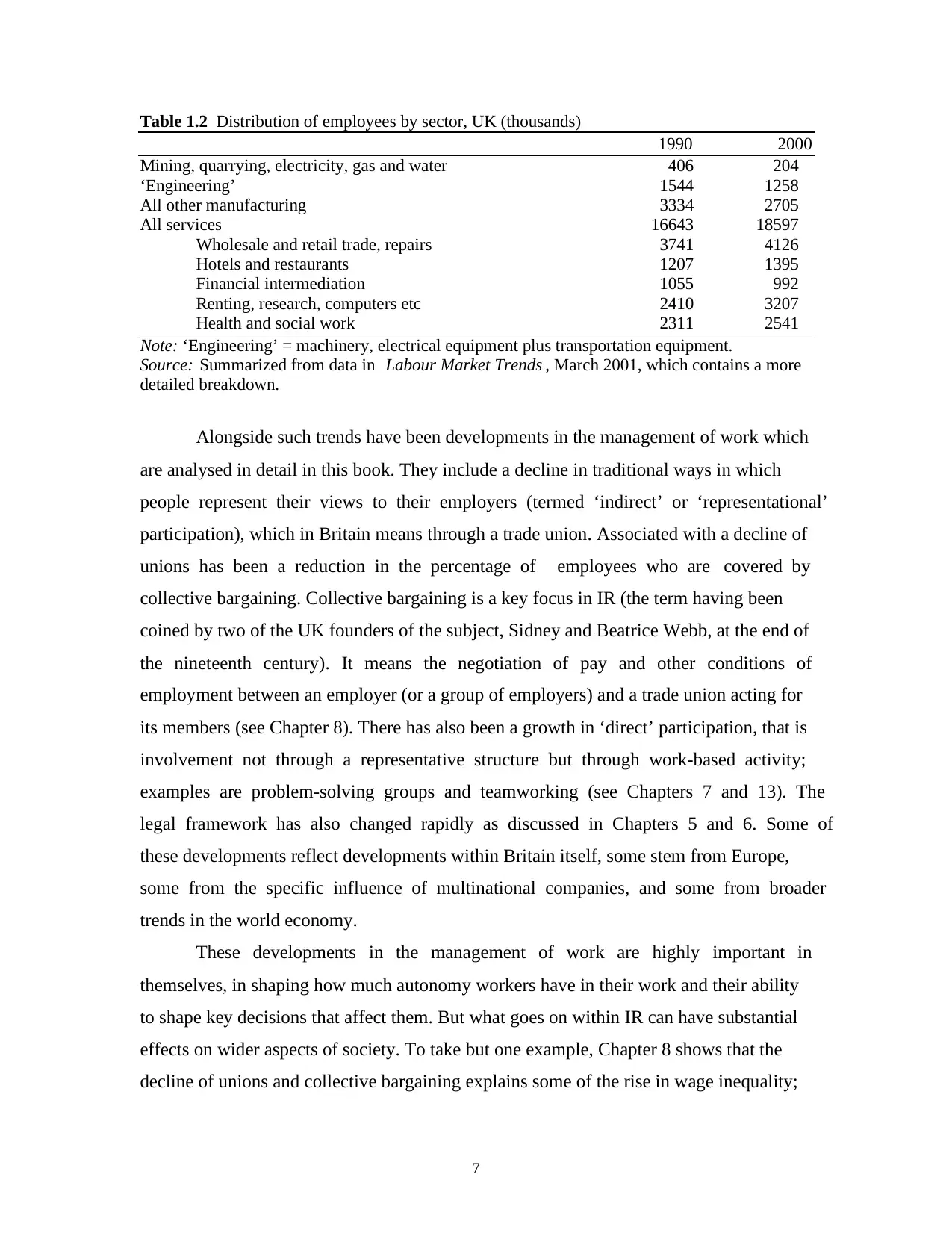
7
Table 1.2 Distribution of employees by sector, UK (thousands)
1990 2000
Mining, quarrying, electricity, gas and water 406 204
‘Engineering’ 1544 1258
All other manufacturing 3334 2705
All services 16643 18597
Wholesale and retail trade, repairs 3741 4126
Hotels and restaurants 1207 1395
Financial intermediation 1055 992
Renting, research, computers etc 2410 3207
Health and social work 2311 2541
Note: ‘Engineering’ = machinery, electrical equipment plus transportation equipment.
Source: Summarized from data in Labour Market Trends , March 2001, which contains a more
detailed breakdown.
Alongside such trends have been developments in the management of work which
are analysed in detail in this book. They include a decline in traditional ways in which
people represent their views to their employers (termed ‘indirect’ or ‘representational’
participation), which in Britain means through a trade union. Associated with a decline of
unions has been a reduction in the percentage of employees who are covered by
collective bargaining. Collective bargaining is a key focus in IR (the term having been
coined by two of the UK founders of the subject, Sidney and Beatrice Webb, at the end of
the nineteenth century). It means the negotiation of pay and other conditions of
employment between an employer (or a group of employers) and a trade union acting for
its members (see Chapter 8). There has also been a growth in ‘direct’ participation, that is
involvement not through a representative structure but through work-based activity;
examples are problem-solving groups and teamworking (see Chapters 7 and 13). The
legal framework has also changed rapidly as discussed in Chapters 5 and 6. Some of
these developments reflect developments within Britain itself, some stem from Europe,
some from the specific influence of multinational companies, and some from broader
trends in the world economy.
These developments in the management of work are highly important in
themselves, in shaping how much autonomy workers have in their work and their ability
to shape key decisions that affect them. But what goes on within IR can have substantial
effects on wider aspects of society. To take but one example, Chapter 8 shows that the
decline of unions and collective bargaining explains some of the rise in wage inequality;
Table 1.2 Distribution of employees by sector, UK (thousands)
1990 2000
Mining, quarrying, electricity, gas and water 406 204
‘Engineering’ 1544 1258
All other manufacturing 3334 2705
All services 16643 18597
Wholesale and retail trade, repairs 3741 4126
Hotels and restaurants 1207 1395
Financial intermediation 1055 992
Renting, research, computers etc 2410 3207
Health and social work 2311 2541
Note: ‘Engineering’ = machinery, electrical equipment plus transportation equipment.
Source: Summarized from data in Labour Market Trends , March 2001, which contains a more
detailed breakdown.
Alongside such trends have been developments in the management of work which
are analysed in detail in this book. They include a decline in traditional ways in which
people represent their views to their employers (termed ‘indirect’ or ‘representational’
participation), which in Britain means through a trade union. Associated with a decline of
unions has been a reduction in the percentage of employees who are covered by
collective bargaining. Collective bargaining is a key focus in IR (the term having been
coined by two of the UK founders of the subject, Sidney and Beatrice Webb, at the end of
the nineteenth century). It means the negotiation of pay and other conditions of
employment between an employer (or a group of employers) and a trade union acting for
its members (see Chapter 8). There has also been a growth in ‘direct’ participation, that is
involvement not through a representative structure but through work-based activity;
examples are problem-solving groups and teamworking (see Chapters 7 and 13). The
legal framework has also changed rapidly as discussed in Chapters 5 and 6. Some of
these developments reflect developments within Britain itself, some stem from Europe,
some from the specific influence of multinational companies, and some from broader
trends in the world economy.
These developments in the management of work are highly important in
themselves, in shaping how much autonomy workers have in their work and their ability
to shape key decisions that affect them. But what goes on within IR can have substantial
effects on wider aspects of society. To take but one example, Chapter 8 shows that the
decline of unions and collective bargaining explains some of the rise in wage inequality;
Paraphrase This Document
Need a fresh take? Get an instant paraphrase of this document with our AI Paraphraser
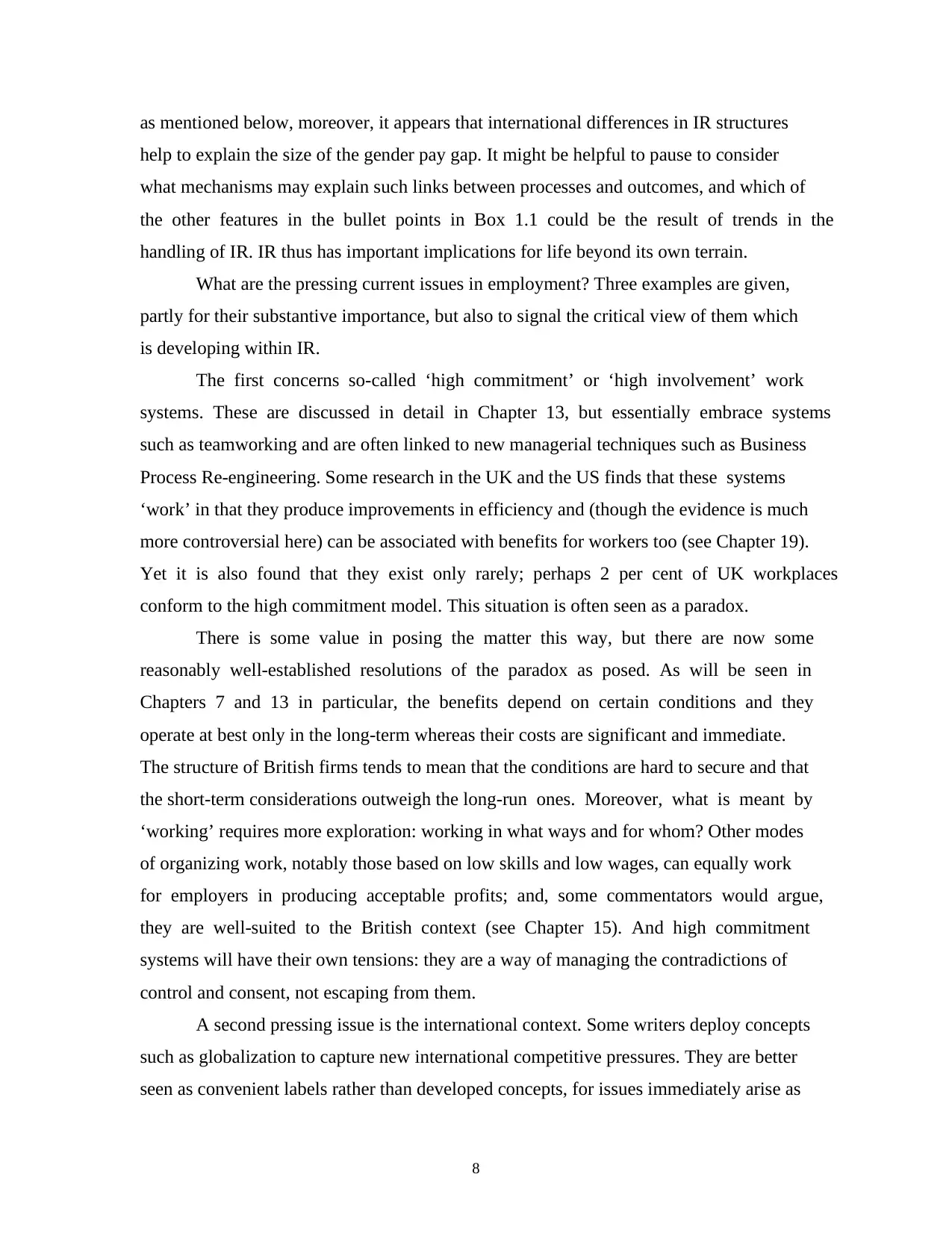
8
as mentioned below, moreover, it appears that international differences in IR structures
help to explain the size of the gender pay gap. It might be helpful to pause to consider
what mechanisms may explain such links between processes and outcomes, and which of
the other features in the bullet points in Box 1.1 could be the result of trends in the
handling of IR. IR thus has important implications for life beyond its own terrain.
What are the pressing current issues in employment? Three examples are given,
partly for their substantive importance, but also to signal the critical view of them which
is developing within IR.
The first concerns so-called ‘high commitment’ or ‘high involvement’ work
systems. These are discussed in detail in Chapter 13, but essentially embrace systems
such as teamworking and are often linked to new managerial techniques such as Business
Process Re-engineering. Some research in the UK and the US finds that these systems
‘work’ in that they produce improvements in efficiency and (though the evidence is much
more controversial here) can be associated with benefits for workers too (see Chapter 19).
Yet it is also found that they exist only rarely; perhaps 2 per cent of UK workplaces
conform to the high commitment model. This situation is often seen as a paradox.
There is some value in posing the matter this way, but there are now some
reasonably well-established resolutions of the paradox as posed. As will be seen in
Chapters 7 and 13 in particular, the benefits depend on certain conditions and they
operate at best only in the long-term whereas their costs are significant and immediate.
The structure of British firms tends to mean that the conditions are hard to secure and that
the short-term considerations outweigh the long-run ones. Moreover, what is meant by
‘working’ requires more exploration: working in what ways and for whom? Other modes
of organizing work, notably those based on low skills and low wages, can equally work
for employers in producing acceptable profits; and, some commentators would argue,
they are well-suited to the British context (see Chapter 15). And high commitment
systems will have their own tensions: they are a way of managing the contradictions of
control and consent, not escaping from them.
A second pressing issue is the international context. Some writers deploy concepts
such as globalization to capture new international competitive pressures. They are better
seen as convenient labels rather than developed concepts, for issues immediately arise as
as mentioned below, moreover, it appears that international differences in IR structures
help to explain the size of the gender pay gap. It might be helpful to pause to consider
what mechanisms may explain such links between processes and outcomes, and which of
the other features in the bullet points in Box 1.1 could be the result of trends in the
handling of IR. IR thus has important implications for life beyond its own terrain.
What are the pressing current issues in employment? Three examples are given,
partly for their substantive importance, but also to signal the critical view of them which
is developing within IR.
The first concerns so-called ‘high commitment’ or ‘high involvement’ work
systems. These are discussed in detail in Chapter 13, but essentially embrace systems
such as teamworking and are often linked to new managerial techniques such as Business
Process Re-engineering. Some research in the UK and the US finds that these systems
‘work’ in that they produce improvements in efficiency and (though the evidence is much
more controversial here) can be associated with benefits for workers too (see Chapter 19).
Yet it is also found that they exist only rarely; perhaps 2 per cent of UK workplaces
conform to the high commitment model. This situation is often seen as a paradox.
There is some value in posing the matter this way, but there are now some
reasonably well-established resolutions of the paradox as posed. As will be seen in
Chapters 7 and 13 in particular, the benefits depend on certain conditions and they
operate at best only in the long-term whereas their costs are significant and immediate.
The structure of British firms tends to mean that the conditions are hard to secure and that
the short-term considerations outweigh the long-run ones. Moreover, what is meant by
‘working’ requires more exploration: working in what ways and for whom? Other modes
of organizing work, notably those based on low skills and low wages, can equally work
for employers in producing acceptable profits; and, some commentators would argue,
they are well-suited to the British context (see Chapter 15). And high commitment
systems will have their own tensions: they are a way of managing the contradictions of
control and consent, not escaping from them.
A second pressing issue is the international context. Some writers deploy concepts
such as globalization to capture new international competitive pressures. They are better
seen as convenient labels rather than developed concepts, for issues immediately arise as
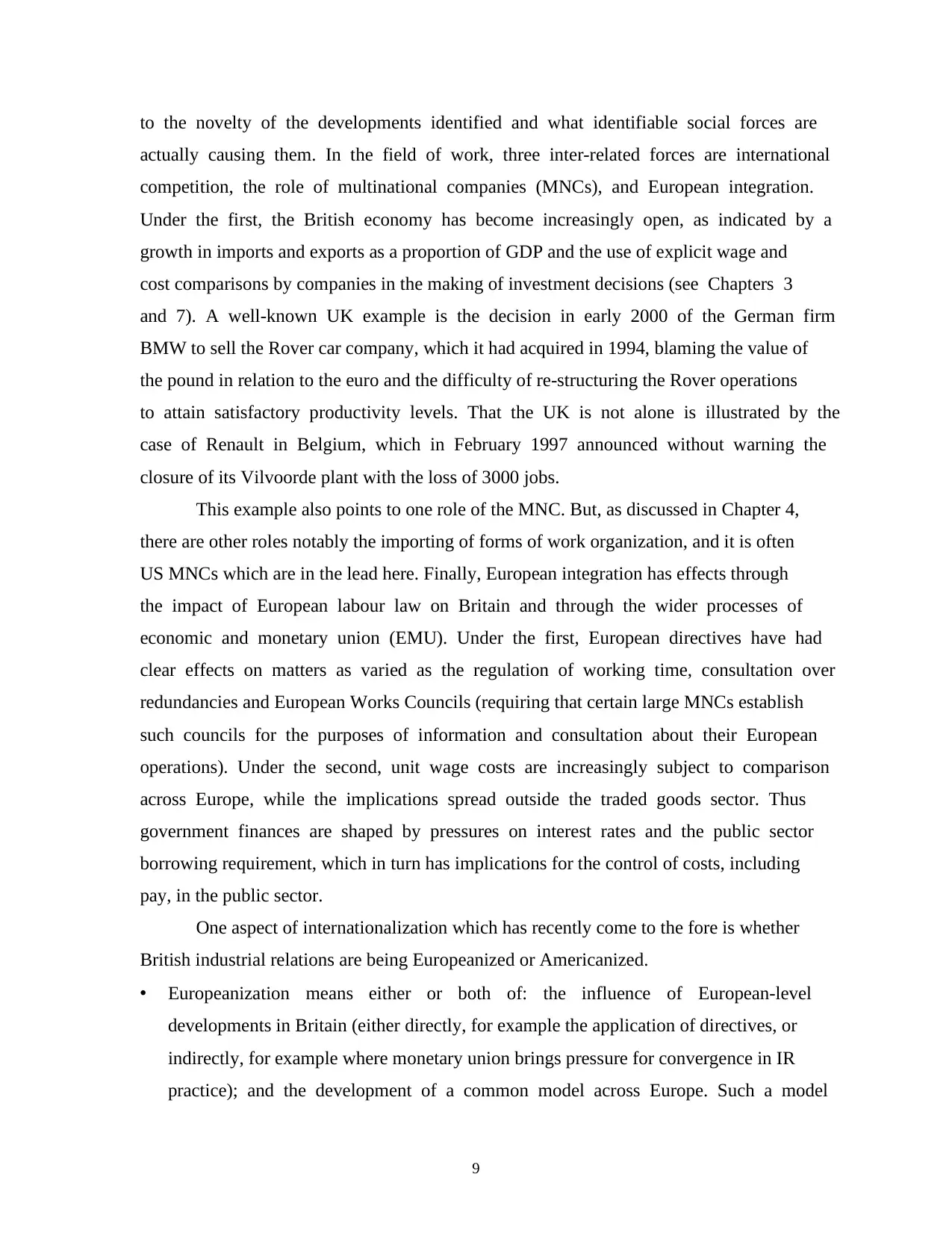
9
to the novelty of the developments identified and what identifiable social forces are
actually causing them. In the field of work, three inter-related forces are international
competition, the role of multinational companies (MNCs), and European integration.
Under the first, the British economy has become increasingly open, as indicated by a
growth in imports and exports as a proportion of GDP and the use of explicit wage and
cost comparisons by companies in the making of investment decisions (see Chapters 3
and 7). A well-known UK example is the decision in early 2000 of the German firm
BMW to sell the Rover car company, which it had acquired in 1994, blaming the value of
the pound in relation to the euro and the difficulty of re-structuring the Rover operations
to attain satisfactory productivity levels. That the UK is not alone is illustrated by the
case of Renault in Belgium, which in February 1997 announced without warning the
closure of its Vilvoorde plant with the loss of 3000 jobs.
This example also points to one role of the MNC. But, as discussed in Chapter 4,
there are other roles notably the importing of forms of work organization, and it is often
US MNCs which are in the lead here. Finally, European integration has effects through
the impact of European labour law on Britain and through the wider processes of
economic and monetary union (EMU). Under the first, European directives have had
clear effects on matters as varied as the regulation of working time, consultation over
redundancies and European Works Councils (requiring that certain large MNCs establish
such councils for the purposes of information and consultation about their European
operations). Under the second, unit wage costs are increasingly subject to comparison
across Europe, while the implications spread outside the traded goods sector. Thus
government finances are shaped by pressures on interest rates and the public sector
borrowing requirement, which in turn has implications for the control of costs, including
pay, in the public sector.
One aspect of internationalization which has recently come to the fore is whether
British industrial relations are being Europeanized or Americanized.
• Europeanization means either or both of: the influence of European-level
developments in Britain (either directly, for example the application of directives, or
indirectly, for example where monetary union brings pressure for convergence in IR
practice); and the development of a common model across Europe. Such a model
to the novelty of the developments identified and what identifiable social forces are
actually causing them. In the field of work, three inter-related forces are international
competition, the role of multinational companies (MNCs), and European integration.
Under the first, the British economy has become increasingly open, as indicated by a
growth in imports and exports as a proportion of GDP and the use of explicit wage and
cost comparisons by companies in the making of investment decisions (see Chapters 3
and 7). A well-known UK example is the decision in early 2000 of the German firm
BMW to sell the Rover car company, which it had acquired in 1994, blaming the value of
the pound in relation to the euro and the difficulty of re-structuring the Rover operations
to attain satisfactory productivity levels. That the UK is not alone is illustrated by the
case of Renault in Belgium, which in February 1997 announced without warning the
closure of its Vilvoorde plant with the loss of 3000 jobs.
This example also points to one role of the MNC. But, as discussed in Chapter 4,
there are other roles notably the importing of forms of work organization, and it is often
US MNCs which are in the lead here. Finally, European integration has effects through
the impact of European labour law on Britain and through the wider processes of
economic and monetary union (EMU). Under the first, European directives have had
clear effects on matters as varied as the regulation of working time, consultation over
redundancies and European Works Councils (requiring that certain large MNCs establish
such councils for the purposes of information and consultation about their European
operations). Under the second, unit wage costs are increasingly subject to comparison
across Europe, while the implications spread outside the traded goods sector. Thus
government finances are shaped by pressures on interest rates and the public sector
borrowing requirement, which in turn has implications for the control of costs, including
pay, in the public sector.
One aspect of internationalization which has recently come to the fore is whether
British industrial relations are being Europeanized or Americanized.
• Europeanization means either or both of: the influence of European-level
developments in Britain (either directly, for example the application of directives, or
indirectly, for example where monetary union brings pressure for convergence in IR
practice); and the development of a common model across Europe. Such a model
⊘ This is a preview!⊘
Do you want full access?
Subscribe today to unlock all pages.

Trusted by 1+ million students worldwide
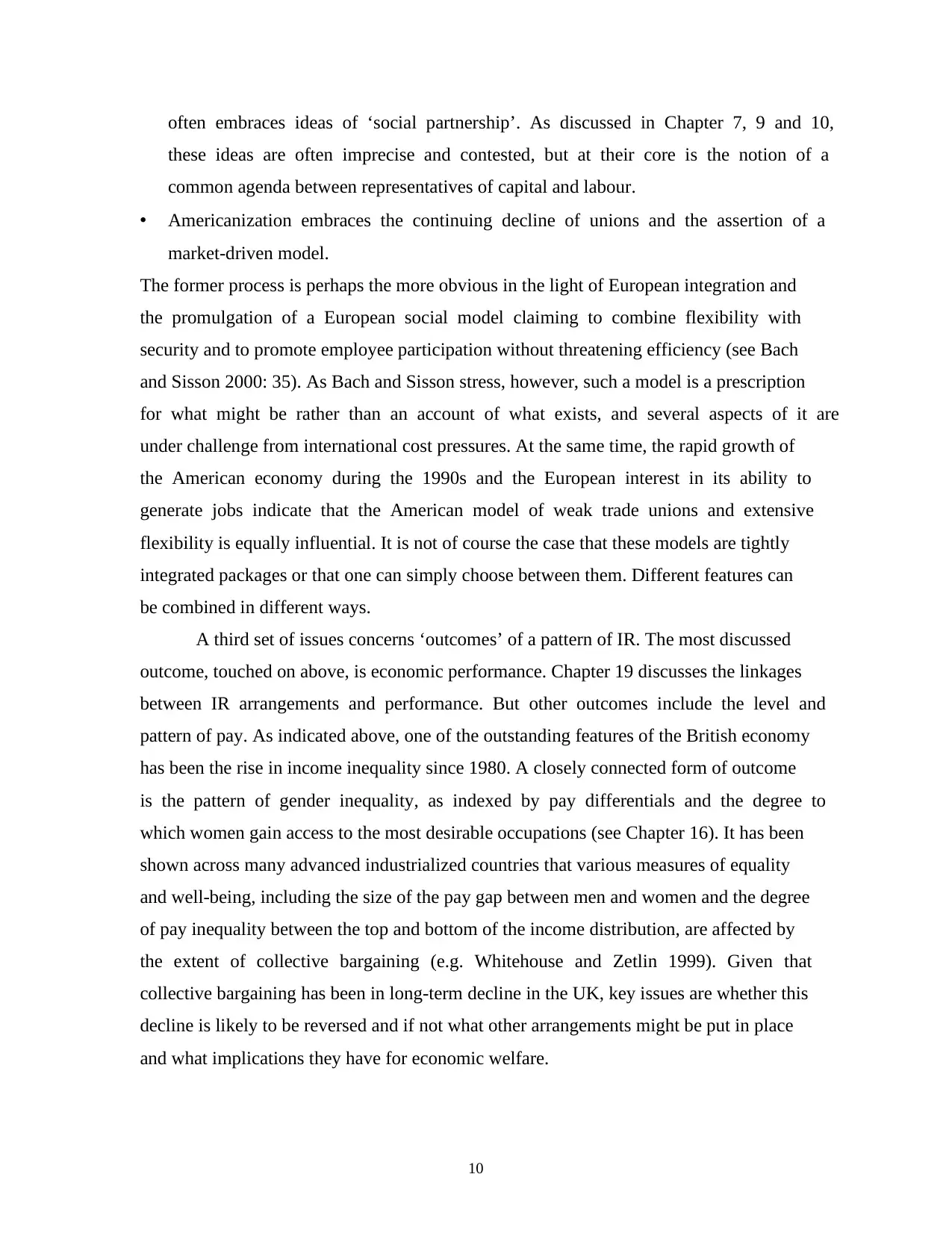
10
often embraces ideas of ‘social partnership’. As discussed in Chapter 7, 9 and 10,
these ideas are often imprecise and contested, but at their core is the notion of a
common agenda between representatives of capital and labour.
• Americanization embraces the continuing decline of unions and the assertion of a
market-driven model.
The former process is perhaps the more obvious in the light of European integration and
the promulgation of a European social model claiming to combine flexibility with
security and to promote employee participation without threatening efficiency (see Bach
and Sisson 2000: 35). As Bach and Sisson stress, however, such a model is a prescription
for what might be rather than an account of what exists, and several aspects of it are
under challenge from international cost pressures. At the same time, the rapid growth of
the American economy during the 1990s and the European interest in its ability to
generate jobs indicate that the American model of weak trade unions and extensive
flexibility is equally influential. It is not of course the case that these models are tightly
integrated packages or that one can simply choose between them. Different features can
be combined in different ways.
A third set of issues concerns ‘outcomes’ of a pattern of IR. The most discussed
outcome, touched on above, is economic performance. Chapter 19 discusses the linkages
between IR arrangements and performance. But other outcomes include the level and
pattern of pay. As indicated above, one of the outstanding features of the British economy
has been the rise in income inequality since 1980. A closely connected form of outcome
is the pattern of gender inequality, as indexed by pay differentials and the degree to
which women gain access to the most desirable occupations (see Chapter 16). It has been
shown across many advanced industrialized countries that various measures of equality
and well-being, including the size of the pay gap between men and women and the degree
of pay inequality between the top and bottom of the income distribution, are affected by
the extent of collective bargaining (e.g. Whitehouse and Zetlin 1999). Given that
collective bargaining has been in long-term decline in the UK, key issues are whether this
decline is likely to be reversed and if not what other arrangements might be put in place
and what implications they have for economic welfare.
often embraces ideas of ‘social partnership’. As discussed in Chapter 7, 9 and 10,
these ideas are often imprecise and contested, but at their core is the notion of a
common agenda between representatives of capital and labour.
• Americanization embraces the continuing decline of unions and the assertion of a
market-driven model.
The former process is perhaps the more obvious in the light of European integration and
the promulgation of a European social model claiming to combine flexibility with
security and to promote employee participation without threatening efficiency (see Bach
and Sisson 2000: 35). As Bach and Sisson stress, however, such a model is a prescription
for what might be rather than an account of what exists, and several aspects of it are
under challenge from international cost pressures. At the same time, the rapid growth of
the American economy during the 1990s and the European interest in its ability to
generate jobs indicate that the American model of weak trade unions and extensive
flexibility is equally influential. It is not of course the case that these models are tightly
integrated packages or that one can simply choose between them. Different features can
be combined in different ways.
A third set of issues concerns ‘outcomes’ of a pattern of IR. The most discussed
outcome, touched on above, is economic performance. Chapter 19 discusses the linkages
between IR arrangements and performance. But other outcomes include the level and
pattern of pay. As indicated above, one of the outstanding features of the British economy
has been the rise in income inequality since 1980. A closely connected form of outcome
is the pattern of gender inequality, as indexed by pay differentials and the degree to
which women gain access to the most desirable occupations (see Chapter 16). It has been
shown across many advanced industrialized countries that various measures of equality
and well-being, including the size of the pay gap between men and women and the degree
of pay inequality between the top and bottom of the income distribution, are affected by
the extent of collective bargaining (e.g. Whitehouse and Zetlin 1999). Given that
collective bargaining has been in long-term decline in the UK, key issues are whether this
decline is likely to be reversed and if not what other arrangements might be put in place
and what implications they have for economic welfare.
Paraphrase This Document
Need a fresh take? Get an instant paraphrase of this document with our AI Paraphraser
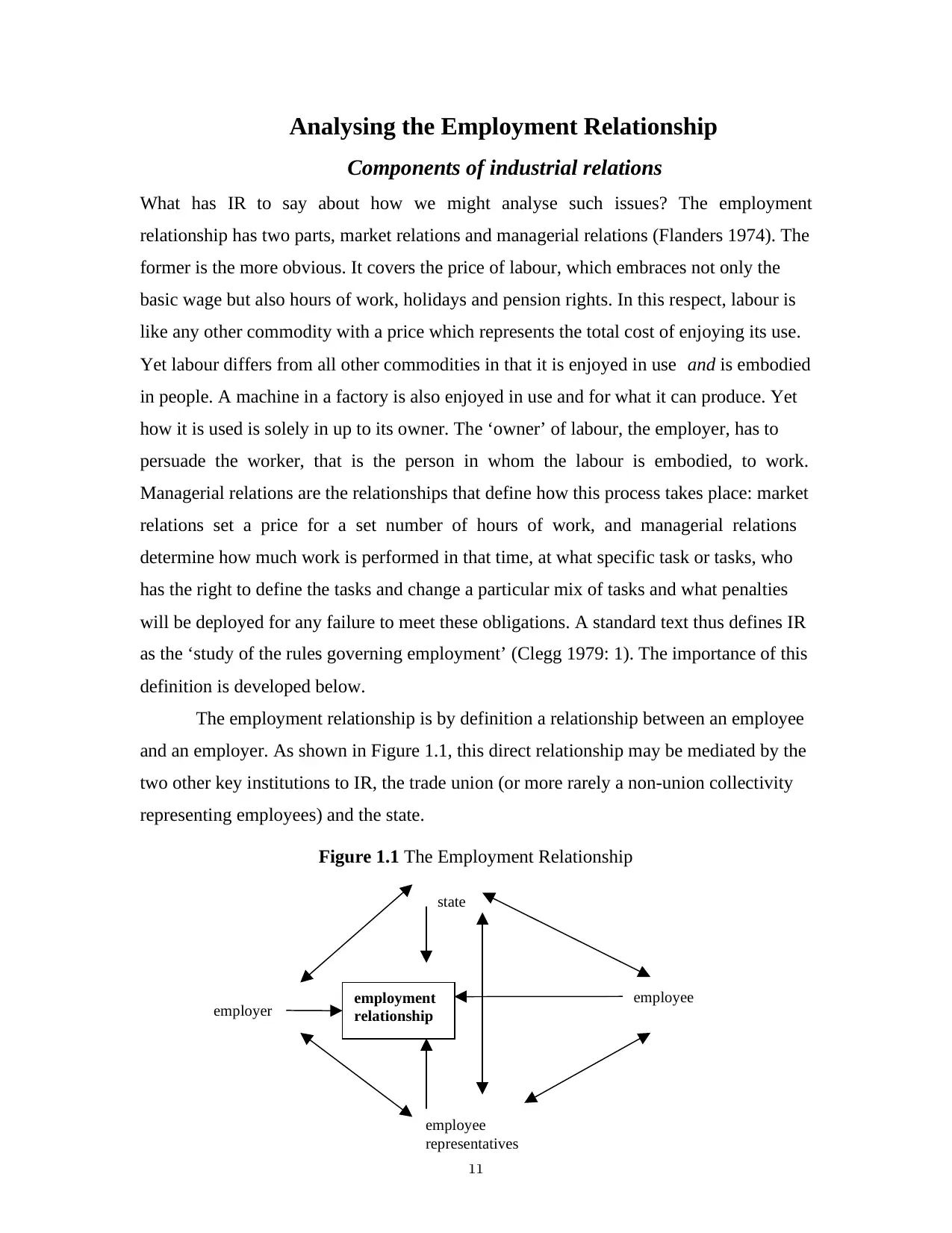
11
Analysing the Employment Relationship
Components of industrial relations
What has IR to say about how we might analyse such issues? The employment
relationship has two parts, market relations and managerial relations (Flanders 1974). The
former is the more obvious. It covers the price of labour, which embraces not only the
basic wage but also hours of work, holidays and pension rights. In this respect, labour is
like any other commodity with a price which represents the total cost of enjoying its use.
Yet labour differs from all other commodities in that it is enjoyed in use and is embodied
in people. A machine in a factory is also enjoyed in use and for what it can produce. Yet
how it is used is solely in up to its owner. The ‘owner’ of labour, the employer, has to
persuade the worker, that is the person in whom the labour is embodied, to work.
Managerial relations are the relationships that define how this process takes place: market
relations set a price for a set number of hours of work, and managerial relations
determine how much work is performed in that time, at what specific task or tasks, who
has the right to define the tasks and change a particular mix of tasks and what penalties
will be deployed for any failure to meet these obligations. A standard text thus defines IR
as the ‘study of the rules governing employment’ (Clegg 1979: 1). The importance of this
definition is developed below.
The employment relationship is by definition a relationship between an employee
and an employer. As shown in Figure 1.1, this direct relationship may be mediated by the
two other key institutions to IR, the trade union (or more rarely a non-union collectivity
representing employees) and the state.
Figure 1.1 The Employment Relationship
employment
relationshipemployer employee
state
employee
representatives
Analysing the Employment Relationship
Components of industrial relations
What has IR to say about how we might analyse such issues? The employment
relationship has two parts, market relations and managerial relations (Flanders 1974). The
former is the more obvious. It covers the price of labour, which embraces not only the
basic wage but also hours of work, holidays and pension rights. In this respect, labour is
like any other commodity with a price which represents the total cost of enjoying its use.
Yet labour differs from all other commodities in that it is enjoyed in use and is embodied
in people. A machine in a factory is also enjoyed in use and for what it can produce. Yet
how it is used is solely in up to its owner. The ‘owner’ of labour, the employer, has to
persuade the worker, that is the person in whom the labour is embodied, to work.
Managerial relations are the relationships that define how this process takes place: market
relations set a price for a set number of hours of work, and managerial relations
determine how much work is performed in that time, at what specific task or tasks, who
has the right to define the tasks and change a particular mix of tasks and what penalties
will be deployed for any failure to meet these obligations. A standard text thus defines IR
as the ‘study of the rules governing employment’ (Clegg 1979: 1). The importance of this
definition is developed below.
The employment relationship is by definition a relationship between an employee
and an employer. As shown in Figure 1.1, this direct relationship may be mediated by the
two other key institutions to IR, the trade union (or more rarely a non-union collectivity
representing employees) and the state.
Figure 1.1 The Employment Relationship
employment
relationshipemployer employee
state
employee
representatives
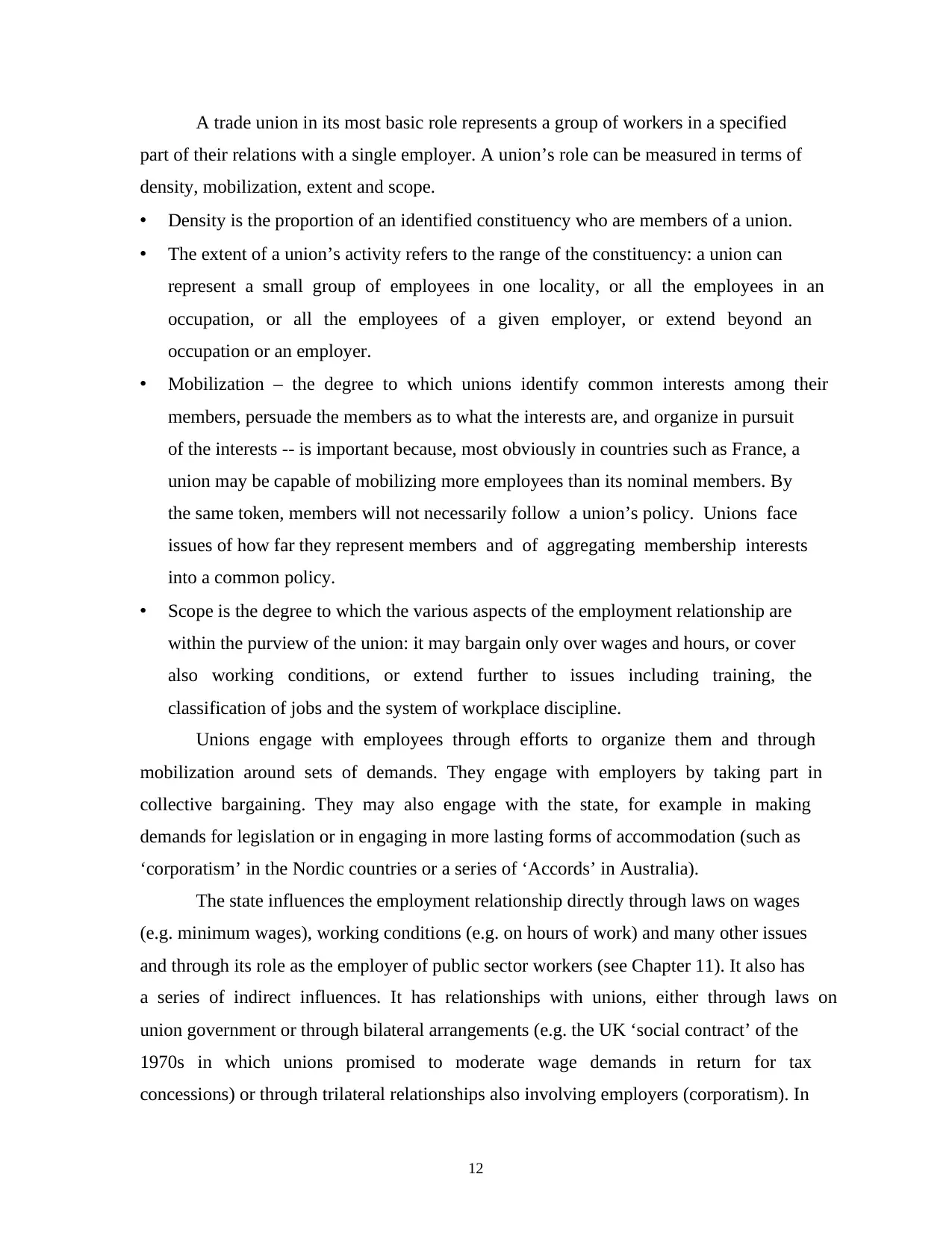
12
A trade union in its most basic role represents a group of workers in a specified
part of their relations with a single employer. A union’s role can be measured in terms of
density, mobilization, extent and scope.
• Density is the proportion of an identified constituency who are members of a union.
• The extent of a union’s activity refers to the range of the constituency: a union can
represent a small group of employees in one locality, or all the employees in an
occupation, or all the employees of a given employer, or extend beyond an
occupation or an employer.
• Mobilization – the degree to which unions identify common interests among their
members, persuade the members as to what the interests are, and organize in pursuit
of the interests -- is important because, most obviously in countries such as France, a
union may be capable of mobilizing more employees than its nominal members. By
the same token, members will not necessarily follow a union’s policy. Unions face
issues of how far they represent members and of aggregating membership interests
into a common policy.
• Scope is the degree to which the various aspects of the employment relationship are
within the purview of the union: it may bargain only over wages and hours, or cover
also working conditions, or extend further to issues including training, the
classification of jobs and the system of workplace discipline.
Unions engage with employees through efforts to organize them and through
mobilization around sets of demands. They engage with employers by taking part in
collective bargaining. They may also engage with the state, for example in making
demands for legislation or in engaging in more lasting forms of accommodation (such as
‘corporatism’ in the Nordic countries or a series of ‘Accords’ in Australia).
The state influences the employment relationship directly through laws on wages
(e.g. minimum wages), working conditions (e.g. on hours of work) and many other issues
and through its role as the employer of public sector workers (see Chapter 11). It also has
a series of indirect influences. It has relationships with unions, either through laws on
union government or through bilateral arrangements (e.g. the UK ‘social contract’ of the
1970s in which unions promised to moderate wage demands in return for tax
concessions) or through trilateral relationships also involving employers (corporatism). In
A trade union in its most basic role represents a group of workers in a specified
part of their relations with a single employer. A union’s role can be measured in terms of
density, mobilization, extent and scope.
• Density is the proportion of an identified constituency who are members of a union.
• The extent of a union’s activity refers to the range of the constituency: a union can
represent a small group of employees in one locality, or all the employees in an
occupation, or all the employees of a given employer, or extend beyond an
occupation or an employer.
• Mobilization – the degree to which unions identify common interests among their
members, persuade the members as to what the interests are, and organize in pursuit
of the interests -- is important because, most obviously in countries such as France, a
union may be capable of mobilizing more employees than its nominal members. By
the same token, members will not necessarily follow a union’s policy. Unions face
issues of how far they represent members and of aggregating membership interests
into a common policy.
• Scope is the degree to which the various aspects of the employment relationship are
within the purview of the union: it may bargain only over wages and hours, or cover
also working conditions, or extend further to issues including training, the
classification of jobs and the system of workplace discipline.
Unions engage with employees through efforts to organize them and through
mobilization around sets of demands. They engage with employers by taking part in
collective bargaining. They may also engage with the state, for example in making
demands for legislation or in engaging in more lasting forms of accommodation (such as
‘corporatism’ in the Nordic countries or a series of ‘Accords’ in Australia).
The state influences the employment relationship directly through laws on wages
(e.g. minimum wages), working conditions (e.g. on hours of work) and many other issues
and through its role as the employer of public sector workers (see Chapter 11). It also has
a series of indirect influences. It has relationships with unions, either through laws on
union government or through bilateral arrangements (e.g. the UK ‘social contract’ of the
1970s in which unions promised to moderate wage demands in return for tax
concessions) or through trilateral relationships also involving employers (corporatism). In
⊘ This is a preview!⊘
Do you want full access?
Subscribe today to unlock all pages.

Trusted by 1+ million students worldwide
1 out of 48
Your All-in-One AI-Powered Toolkit for Academic Success.
+13062052269
info@desklib.com
Available 24*7 on WhatsApp / Email
![[object Object]](/_next/static/media/star-bottom.7253800d.svg)
Unlock your academic potential
Copyright © 2020–2025 A2Z Services. All Rights Reserved. Developed and managed by ZUCOL.